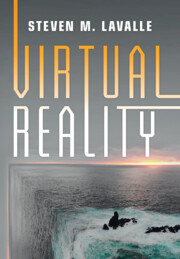Refine search
Actions for selected content:
1206 results in Computer Graphics, Image Processing and Robotics
Preface
-
- Book:
- Analytic Projective Geometry
- Published online:
- 05 October 2023
- Print publication:
- 19 October 2023, pp xi-xii
-
- Chapter
- Export citation

Virtual Reality
-
- Published online:
- 12 October 2023
- Print publication:
- 02 November 2023

Analytic Projective Geometry
-
- Published online:
- 05 October 2023
- Print publication:
- 19 October 2023
Part IV - Concluding Remarks
-
- Book:
- Verifiable Autonomous Systems
- Published online:
- 25 May 2023
- Print publication:
- 08 June 2023, pp 239-240
-
- Chapter
- Export citation
7 - Multi-Agent Auctions
- from Part II - Applications
-
- Book:
- Verifiable Autonomous Systems
- Published online:
- 25 May 2023
- Print publication:
- 08 June 2023, pp 83-103
-
- Chapter
- Export citation
6 - Agent-Based Autonomous System Verification
- from Part I - Foundations
-
- Book:
- Verifiable Autonomous Systems
- Published online:
- 25 May 2023
- Print publication:
- 08 June 2023, pp 68-80
-
- Chapter
- Export citation
8 - Autonomous Satellite Control
- from Part II - Applications
-
- Book:
- Verifiable Autonomous Systems
- Published online:
- 25 May 2023
- Print publication:
- 08 June 2023, pp 104-126
-
- Chapter
- Export citation
2 - Autonomous Systems Architectures
- from Part I - Foundations
-
- Book:
- Verifiable Autonomous Systems
- Published online:
- 25 May 2023
- Print publication:
- 08 June 2023, pp 13-23
-
- Chapter
- Export citation
Frontmatter
-
- Book:
- Verifiable Autonomous Systems
- Published online:
- 25 May 2023
- Print publication:
- 08 June 2023, pp i-iv
-
- Chapter
- Export citation
Part I - Foundations
-
- Book:
- Verifiable Autonomous Systems
- Published online:
- 25 May 2023
- Print publication:
- 08 June 2023, pp 11-12
-
- Chapter
- Export citation
11 - Compositional Verification: Widening Our View beyond the Agent
- from Part III - Extensions
-
- Book:
- Verifiable Autonomous Systems
- Published online:
- 25 May 2023
- Print publication:
- 08 June 2023, pp 177-202
-
- Chapter
- Export citation
Appendix A - Gwendolen Documentation
-
- Book:
- Verifiable Autonomous Systems
- Published online:
- 25 May 2023
- Print publication:
- 08 June 2023, pp 246-296
-
- Chapter
- Export citation
13 - Utilising External Model-Checkers
- from Part III - Extensions
-
- Book:
- Verifiable Autonomous Systems
- Published online:
- 25 May 2023
- Print publication:
- 08 June 2023, pp 218-238
-
- Chapter
- Export citation
10 - Ethical Decision-Making
- from Part II - Applications
-
- Book:
- Verifiable Autonomous Systems
- Published online:
- 25 May 2023
- Print publication:
- 08 June 2023, pp 150-174
-
- Chapter
- Export citation
Part II - Applications
-
- Book:
- Verifiable Autonomous Systems
- Published online:
- 25 May 2023
- Print publication:
- 08 June 2023, pp 81-82
-
- Chapter
- Export citation
Appendix C - AJPF Documentation
-
- Book:
- Verifiable Autonomous Systems
- Published online:
- 25 May 2023
- Print publication:
- 08 June 2023, pp 330-361
-
- Chapter
- Export citation
12 - Runtime Verification: Recognising Abstraction Violations
- from Part III - Extensions
-
- Book:
- Verifiable Autonomous Systems
- Published online:
- 25 May 2023
- Print publication:
- 08 June 2023, pp 203-217
-
- Chapter
- Export citation
Introduction
-
- Book:
- Verifiable Autonomous Systems
- Published online:
- 25 May 2023
- Print publication:
- 08 June 2023, pp 1-10
-
- Chapter
- Export citation
Index
-
- Book:
- Verifiable Autonomous Systems
- Published online:
- 25 May 2023
- Print publication:
- 08 June 2023, pp 373-378
-
- Chapter
- Export citation
9 - Certification of Unmanned Air Systems
- from Part II - Applications
-
- Book:
- Verifiable Autonomous Systems
- Published online:
- 25 May 2023
- Print publication:
- 08 June 2023, pp 127-149
-
- Chapter
- Export citation
